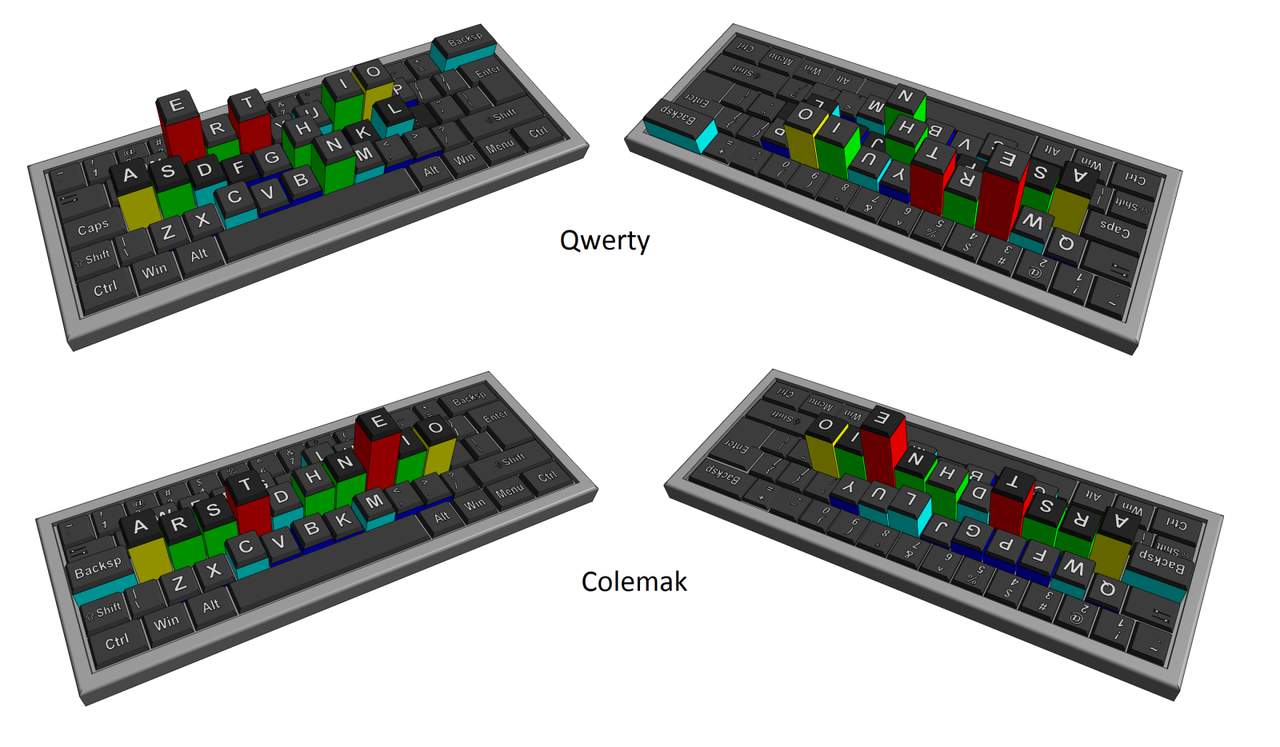Eventually I made the move.
I type most of the time when I work. My left hand hurts from time to time as one of its nurves was cut in an surgery accident when I was a kid, and my left hand could not type as comfortably and fast as my right one. In my 20+ years of playing with keyboards, the pain keeps bothering me. Well I hope not any more, or not as often, after this switch.
Last month when I was browsing a mechanical keyboard forum, I saw people talking about alternative keyboard layouts, Dvorak, Colemak, Walkman etc. It’s not my first time hearing about these layouts: they tried to replace QWERTY by arranging the most used keys in the home row, so people can type faster. Not interested, I was. With QWERTY I type at about 80 WPM, good enough for coding and email. However, I then came across this article showing a wonderful heat distribution of QWERTY keyboard and a Colemak one:

The comparison clearly shows the most frequently pressed keys in QWERTY are distributed across the rows, while in Colemak they are all in the home row. There is another research claims that Colemak puts right hand into more use: perfect for my case!
Then I decide it is time for me to switch.
It is always the first step that costs. Ih the first few days, I felt nothing but frustration: it seems like the fingers don’t belong to me anymore. After 20 years, I don’t even know how to type! In the first week I practised everyday, yet I was typing at about 35 WPM. I used the ‘cold turkey’ method, and therefore my work suffered in the slow typing as well.
The second week I thought about giving up, mostly because I could not bear the impact to my work. Especially when coding with a colleague behind me, I had to explain I was in the transition to a new keyboard layout blah blah. Mine! I screwed myself! But soon after I realize there is no way back: because I practiced a lot, part of my muscle memory has adapted the Colemak layout. So when I tried to switch back to QWERTY, I could not type either! I will never forget the feeling: the nerves connecting my brain and the fingers are broken. I can see the fingers, but they are not at my command…
Well this might be just a good thing. I quickly decided to continue the journey to Colemak. And about 1 month later, my average speed is above 50 WPM, sometimes over 65 WPM. Not bad for fhe first month! And at this speed I can pretty much get my work going without much delay.
And I have to say Colemak really make typing a much more enjoyable experience: the layout is optimized to achieve the ‘flow’ of typing. Typing many words in Colemak feels like playing the piano and your fingers are just following the flow of keys. I was good enough in QWERTY but I never enjoy typing with the layout. With Colemak I feel the comfort and fun while typing. This is amazing and you have to experience it yourself to tell. Now I understand the comment by most of the users coming from QWERTY to Colemak: I will never go back.
Now I am confident that given some time, I will be able to come back to the speed I had with QWERTY, or maybe even faster. But spped is not the number 1 factor in this transition. I am more comfortable with working on a Colemak keyboard for a long time.
One note for those who would also like to make the switch: get yourself a programmable keyboard, likely and preferrably, a mechanical keyboard. With the keyboard you will be able to program it to the Colemak layout. And with the keyboard you will not worry if a PC or a laptop has install the software to support Colemak. I find it very helpful and besides, a mechanical keyboard is much better than those $5 membrane ones!
If you work more than 4 hours with a keyboard, you deserve Colemak and a good mechanical keyboard. =)